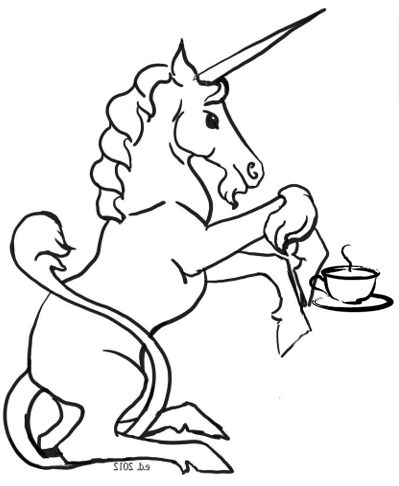
|
"That perfection is unobtainable is not an excuse not to strive for it."
|

|

|
"That perfection is unobtainable is not an excuse not to strive for it."
|

|
 |
When the Unicorn came to tea, quite a good deal of fun had we! Have a cake, said he; take two, said me. So, of course, we both had three!
There were cakes & cookies galore,
The Hatter was certainly mad.
The Hare came over to see
The Dormouse came out to play.
What on the desk do I see? |
The Unicorn Came to Tea in a 6 limerick poem. A limerick is a five line poem in which the 1st, 2nd, and 5th lines rhyme and have 3 beats each, and the 3rd and 4th lines rhyme and each have 2 beats.
Some folks cite an 11th century manuscript as having the first written limerick meter poem. While others point out that Willie Shakespeare stuck a few in some in his wacky plays ("Othello", "King Lear", and "The Tempest.").[1]
A good rule of thumb in SCA documentation is: if you can find it in Shakespeare or the bible then it's period ... So we're good there.
You might think that this limerick poem reminds you of a something that happened to a young girl in 1865, but that is after our time period so it's probably just a coincidence! In addition Poe wrote on The Raven, and the desk, in 1845 so we will talk about that Nevermore!
The Hunt of the Unicorn Tapestries (aka The Unicorn Tapestries) were woven between 1495 and 1505 and provide us proof that both unicorns and rabbits existed in period.
We can do even better with ravens ... they are included in the Poetic Edda[2], (compiled in the 13th century from earlier traditional sources) as the BFFs (Best Feathered Friends) of dear old Odin! Viking poems are as golden as Shakespeare and the bible for documentation!!
The dormouse has been in Europe from the Early Eocene Epoch (54.8 million to 49 million years ago)[3], so along with the raven, they’re good!
Our poor mad hatter was wigged out from using mercuric nitrate while making felt hats. The practice "began in 17th century France and spread to England by the end of the century.[4]
Even the British, admit that the Dutch were the first Europeans brave enough to start drinking tea! The first batch came over in 1606![5] Which fits into our unofficially expanded SCA period of study, so there!
Cakes[6], cookies[7], cream[8,9], and sugar[10] are all period, trust me! Although, not so much if you were a peasant!!
Notes
1. Douma, Michael, curator. "The mischievous limerick." Poetry through the Ages. 2008. Institute for Dynamic
Educational Development. Accessed 14 March 2018,
2. Bellows, Henry Adams. The Poetic Edda. American-Scandinavian Foundation, 1923
3. Britannica, The Editors of Encyclopaedia. "Dormouse." Encyclopedia Britannica, Encyclopedia Britannica, Inc., 15
Feb. 2016, www.britannica.com/animal/dormouse.
4. "History." Mercury, A Unity College Student-Faculty Project, 15 Sept. 2014, Accessed 15 March 2018
www.environmentalhistory.org/mercury/history>
5. "Tea - A Brief History of the Nation's Favourite Beverage." Tea - A Brief History of the Nation's Favourite
Beverage, UK Tea & Infusions Association, 2018, Accessed 15 March 2018,
6. Olver, Lynne. "About Cake." The Food Timeline: Cake History Notes, Accessed 15 March 2018,
7. Stradley, Linda. "History Of Cookies, Whats Cooking America." History of Cookies, What’s Cooking America,
7 Nov. 2016, Accessed 15 March 2018,
8. Curry, Andrew. "Archaeology: The Milk Revolution." Nature News, Nature Publishing Group, 31 July 2013,
Accessed 15 March 2018,
9. "Cream Meaning in the Cambridge English Dictionary." Cambridge Dictionary, Cambridge University Press, Accessed 15 March 2018,
10. Pringle, Heather. "Sugar Masters in a New World." Smithsonian.com, Smithsonian Institution, 12 Jan. 2010,
Accessed 15 March 2018,
Sales pages: Unicorn Fiber Arts *
Brown Owl Brew Shop
Main page: House Zacharia
If these pages were useful or entertaining
Questions? Comments? Whatever? Email